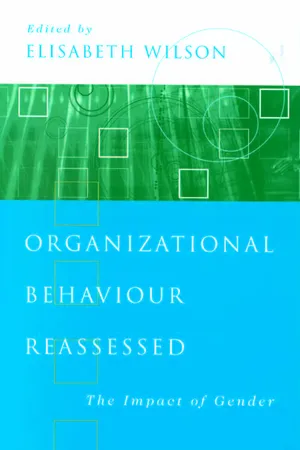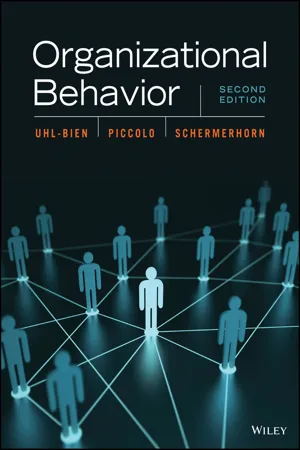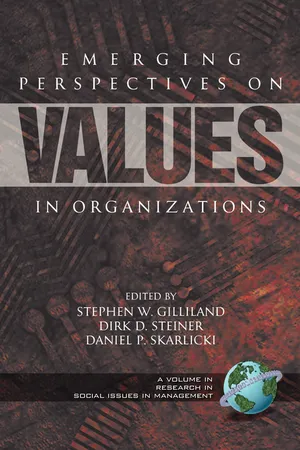Business
Personality and Values
Personality refers to the unique set of characteristics and traits that define an individual's behavior and interactions. Values are the beliefs and principles that guide a person's attitudes and actions. In a business context, understanding employees' personalities and values is crucial for effective management, team dynamics, and organizational culture.
Written by Perlego with AI-assistance
Related key terms
1 of 5
12 Key excerpts on "Personality and Values"
- eBook - PDF
Corporate Social Entrepreneurship
Integrity Within
- Christine A. Hemingway(Author)
- 2013(Publication Date)
- Cambridge University Press(Publisher)
part ii Personal values and corporate social entrepreneurship 4 The relationship between personal values and behaviour Personal values have been acknowledged as important components in the process of human perception (England 1967), not least because of their connection to our our emotions and our social norms (Jacob, Flink and Schuchman, 1962). This indicates the significance of values as an integral facet of human decision making (March and Simon, 1958: 11). In what follows, a value is defined as a cognitive struc- ture which combines with our emotion and plays a pivotal role in our decision making and subsequent actions. Here we see parallels with personality characteristics, although personal values are defined by scholars as standards of conduct. This connects the study of value with ideas about morality, including virtue ethics theory. Moreover, some scholars differentiate between a personality characteristic or trait and a personal value on the basis of what is thought to be the more enduring nature of personality compared with values. This is a moot point, however, with relatively little empirical investigation of values in business and management compared with the vast literature on personality. Furthermore, a personal value, or standard of conduct, is thought to function as part of our survival mechanisms, driving behaviour as an expression of the self and also in the interest of the wel- fare of the group. Hence the notion of individualistic and collectivistic values emerges in both psychology and sociology. However, whilst the individual is likely to possess a combination of values, the idea of either dominant individualistic or collectivistic values that emerge in particular circumstances has significant support in the social psy- chology literature. - eBook - PDF
The Leader′s Shadow
Exploring and Developing Executive Character
- William Q. Judge(Author)
- 1999(Publication Date)
- SAGE Publications, Inc(Publisher)
The Nature of Personal Values Having stated the importance of clarifying personal values, it is useful to distinguish between public and private values. Sometimes, individuals identify certain values as being near and dear to their hearts (i.e., private values); however, their actual behavior (i.e., pub- Personal Values of Executive Leaders 65 lie values) indicates otherwise. What could account for this discrep-ancy between a person's public and private values? One possibility is the person knows his preferred values but realizes that these values conflict with the organization's primary values and suppresses his opinions and behaviors for fear of reprisals (Bartolome, 1989). As a result, the public values are merely rationalizations or aspirations (Schein, 1990). Another possibility is that the person has weak or transient values and does not know his core values. These people would rather adopt external, and often foreign, values rather than investigating their own core beliefs (Covey, 1989). In either case, the individual has generated an internal conflict that must eventually be reconciled. A second notion that is important to recognize about personal values is that we can often hold several different values simultaneously. Because values sometimes conflict within us, we must often set priori-ties among them. Thus, values operate as a system within us that some believe is ordered within a personal hierarchy. Furthermore, value systems can change over time as a direct result of social influences, personal maturation, or both (Rokeach, 1973). While it is possible for value systems to change over time, they sometimes remain the same over a lifetime, and if they do change, they do so very slowly. There are two possible explanations for this. First, values often remain in the unconscious mind, determining a person's behavior, but because they are not consciously chosen, these values are not readily apparent to their holder (Rokeach, 1973). - eBook - PDF
Personality, Values, Culture
An Evolutionary Approach
- Ronald Fischer(Author)
- 2017(Publication Date)
- Cambridge University Press(Publisher)
In other words, values can be seen as motivational orientations that capture general life goals and instructions of how to achieve them (Fischer, 2013). Gordon Allport (1955), one of the grandfathers of psychology, claimed that the study of values was impor- tant for understanding the personality of individuals in his seminal book, Becoming. Influential pioneers of personality research adopted definitions of personality that encompassed values as important aspects of personality (Guilford, 1959). Yet, the study of values has developed separately from per- sonality, and today there is little reference to values in standard texts on per- sonality (Bilsky & Schwartz, 1994; Nilsson, 2014). A major and obvious dif- ference between the two is that researchers typically measure traits in terms Basic Human Values 35 of how people typically behave, whereas values are typically rated in terms of their importance. Therefore, trait dimensions capture perceived behav- ioral consistencies, whereas values capture what people deem important in their lives. Much of the modern research on values within psychology has its roots in the classic sociological work by Kluckhohn and Strodtbeck (1961) that examined value orientations in small communities in the United States dur- ing the late 1940s and 1950s. This early work had some strong influence on later cross-national studies such as Hofstede’s (1980) work. Hofstede stud- ied value-like statements among IBM employees in the 1960s and 1970s and developed his famous four-dimensional model of cultural values. The dimension that has attracted most attention is individualism-collectivism, which captures the importance of the individual versus the group. Yet, Hof- stede’s work was at the societal level and did not provide much insight into the values of individuals. From an individual perspective, Milton Rokeach’s (1968, 1973) work on values in sociology had the largest influence on empirical value research in psychology. - eBook - PDF
Organizational Behaviour Reassessed
The Impact of Gender
- Elisabeth M Wilson(Author)
- 2000(Publication Date)
- SAGE Publications Ltd(Publisher)
Personality is the combination of stable physical and mental characteristics that make up an individual's identity and give consistency to the person's behaviour (Weiss, 1996: 30). An individual's personality is the combination of psychological traits we use to classify that person (Robbins, 1992: 31). Personality is manifested in the behaviour, manners and attitudes of individuals. Personality theory is a field of science that has to do with the search for those attributes of people which are relatively enduring and which help define some important aspect of their individual identities (Hosking and Morley, 1991: 7). Organizational Behaviour Reassessed 18 The idea that personality characteristics are stable, and the idea of individual identity that they support, seems to offer a common ground for these definitions. Gender is an integral part of individual identity. It can also be said that gender constitutes identity and embodies it. Bodies always convey a gendered identity, even if sometimes a false one, as is the case for transsexual identities. Gender identities are formed and moulded in public and in private, in society, in culture, in families, at work and in social life. The patterns and processes of socialization are not constant and rigid, but vary over time, culture and other factors. The reasons why personality has always been popular in the organizational behaviour literature are manifold. One reason might be that managers benefit from personality theories, particularly on those that can be measured, tested and used for feedback to improve, adjust, train and make decisions about employee behaviour. Performance is, after all, based on behaviour. Managers are interested in personal dynamics as they affect behaviour and therefore performance (Weiss, 1996). Personality assessments are most commonly made through self-report questionnaires, projective tests and behavioural measures. - eBook - ePub
Personal Values and Managerial Behaviour
A Comparative Analysis from Central Europe
- Zlatko Nedelko, Vojko Potocan(Authors)
- 2019(Publication Date)
- Palgrave Pivot(Publisher)
2000 ).In this respect, in sociological, psychological and business literature there exist several definitions of personal values (Gibb & Burns, 2018 ; Kluckhohn & Strodtbeck, 1961 ; Rokeach, 1973 ; Schwartz, 1992 ). For example, Haralambos and Holborn (2013 ) consider values as beliefs that something is good and desired, and define what is important, what pays off and what is worth the effort. More specific definitions of values are developed for particular considerations of human behaviour (Jones & George, 2014 ; Minton & Khale, 2014 ; Smith et al., 2002 ), such as that by Haslam (2007 , p. 15) who reckons that ‘values represent abstract goals, which are realized in different situations and motivate individual’s behaviour’, and Fisher and Schwartz (2006 , p. 1131) who define values ‘as key ideas about how people should live and which goals should be followed’.The personal values of each individual create his/her specific values system and determine the importance of single values and relationships between these single values for them (England, 1975 ; Rokeach, 1968 ; Schwartz et al., 2012 ). In addition, the relative importance of single values for individuals results in the determination of a unique hierarchical system of his/her values (Rokeach, 1973 ). Based on their different priorities, humans practice different behaviours. In that frame, we can argue that the more important values are higher in the hierarchy, such as core values, and are more durable, stable and generally accepted. Inversely, some values can be treated as peripheral, which are less important, less durable, less stable and are not well accepted by most members of society . Values theorists posit that ‘humans’ personal values system is relatively durable and stable, but their hierarchy can change along with changes in society, culture, personal experience, etc., which can influence changing of the relative importance of single values for the individual’ (Rokeach, 1973 - eBook - PDF
- Mary Uhl-Bien, Ronald F. Piccolo, John R. Schermerhorn, Jr.(Authors)
- 2020(Publication Date)
- Wiley(Publisher)
3.2 Values 3-15 3.2 Values LEARNING OBJECTIVES Identify what values are and why they matter in OB. • Describe what values are and where they come from. • Explain how values play out across different national cultures using the Hofstede framework. As described by noted psychologist Milton Rokeach in his influential book, The Nature of Human Values, values reflect a person’s sense of right and wrong or what ought to be. 24 Statements like, “Equal rights for all” and “People should be treated with respect and dignity” are indicators of values. Values such as these are important because they influence attitudes and behavior. Understanding them helps us to know what people think is important, what they are motivated by, and how two close friends can interpret the same situation very differently. What Are Values and Where Do They Come From? Values are broad preferences concerning appropriate courses of action or outcomes. They rep- resent a strongly held belief about what is valued, important, and acceptable. We can think of values as an individual’s code of ethics or belief system that acts as a guiding principle for things encountered in life. Our values develop as a product of the learning from experience we encounter in the cul- tural settings in which we live. Many individual values have their roots in early childhood and the way they were raised. 25 Parents, friends, teachers, siblings, education, experience, and external reference groups all have some influence on an individual’s values. In general, values tend to be stable, and they are typically ordered in importance relative to one another. For example, you might value integrity above all, followed by achievement, benevolence, and security. Terminal and Instrumental Values Milton Rokeach classified values into two broad categories. 26 Terminal values reflect a person’s preferences concerning the ends to be achieved; they are the goals an individual would like to attain during his or her lifetime. - eBook - PDF
- Mary Uhl-Bien, John R. Schermerhorn, Jr., Richard N. Osborn(Authors)
- 2013(Publication Date)
- Wiley(Publisher)
52 Statements like “Equal rights for all” and “People should be treated with respect and dignity” are indicators of values. And we recognize that values tend to influence attitudes and behavior. Sources of Values Parents, friends, teachers, siblings, education, experience, and external reference groups are all possible influences on individual values. Our values develop as a product of the learning and experience we encounter in the cultural setting in which we live, as learning and experiences differ from one person to another. Value differences result. Such differ- ences are likely to be deep seated and difficult (though not impossible) to change. Many have their roots in early childhood and the way a person has been raised. 53 Personal Values The noted psychologist Milton Rokeach classified values into two broad categories. 54 Terminal values reflect a person’s preferences concerning the “ends” to be achieved; they are the goals an individual would like to achieve during his or her lifetime. Instrumental values reflect the “means” for achieving desired ends. They represent how you might go about achieving your important goals. Rokeach identifies the eighteen terminal values and eighteen instrumental values shown in Figure 2.3. Take a look at the list. Then ask this: What are my top five values, and what do they say about me and how I relate or work with others? Bruce Meglino and colleagues discuss the importance of value congruence between leaders and followers. 55 It occurs when individuals express positive feelings upon encoun- tering others who exhibit values similar to their own. When values differ, or are incongruent, conflicts over such things as goals and the means to achieve them may result. Research finds that satisfaction with a leader is greater when there is congruence among the four values of achievement, helping, honesty, and fairness. - eBook - ePub
The Culture Engine
A Framework for Driving Results, Inspiring Your Employees, and Transforming Your Workplace
- S. Chris Edmonds(Author)
- 2014(Publication Date)
- Wiley(Publisher)
Chapter 4 Define Values in Behavioral TermsCongratulations! You've finished your purpose statement, which outlines your team's or company's reason for being. You will soon begin the socialization of this draft purpose statement—and you will learn a great deal.You will spend time and energy in refining the purpose statement. Every discussion, every dialogue, will bring greater clarity to you and your team members about your team's reason for being. Now let's shift our focus to values.The next step in creating your organizational constitution is to define the positive values and behaviors you want every leader and employee to demonstrate in every interaction with team members and customers.Values—and values defined in behavioral terms—are the most important element of your organizational constitution. The values and behaviors that you decide are required in your team or company will be examined, judged, engaged with, and (it is hoped) embraced for years to come.Values and valued behaviors are the most visible demonstration of your organizational constitution. Values and valued behaviors are the evidence of your constitution that is noticed by people—customers, potential employees, everyone who comes into contact with your team members.Values and valued behaviors are the unique theme of your organization's culture that differentiates your company from other companies. They attract like-minded (and values-aligned) potential employees and customers, and create heart-driven momentum that builds performance and engagement across the organization.Two highly values-driven companies, Southwest Airlines and Zappos,1 are examples of companies that hire and coach to their specific, defined, desired valued behaviors. With the right values, character, and heart in place, aligning skill sets to the role is easy.Values alignment rarely happens casually. It happens so rarely that we can confidently say the chances of values alignment happening in your company or team without intentional effort - eBook - PDF
Perspectives on Leadership
From the Science of Management to Its Spiritual Heart
- Gilbert W. Fairholm(Author)
- 2000(Publication Date)
- Praeger(Publisher)
Values supporting this overarching value are those of rationality, efficiency, loyalty to the group and adaptability. Thayer (1980) sees values as operationally sim- ilar to objectives, goals, ends, purposes or policies. As corporation mem- bers accept a particular set of values and act upon them, they become the truth for them. Values that strengthen and perpetuate the corpo- ration, and not the individual, may be the source of much of the pres- sure some see in corporate life. For Burns (1978) values are standards that can be used to establish choices made, determine equity and balance policies and practices. In his seminal work on leadership, Burns also suggests that values can be a source of vital change in people and organizations. The central task is to manage values conflict in favor of a shared value system. Leaders appeal to widely held end values they and their followers come to esteem. 8 Principles of Values-based Leadership Theory Values-based leadership theory is clear and uncomplicated. It is leader action to create a culture supportive of values that leads to mutual growth and enhanced self-determination. Implementation, however, requires a major shift in one's mind. Indeed, this is the centerpiece of values theory: adoption of a specific virtual environment that facilitates realization of these process and outcome desires. The true essence of leadership is not in procedures. It is in setting and teaching values to followers. Of the many tasks all leaders have to do, some are more essential than others. There are structures to build and maintain, programs to manage, procedures to create and implement and policies to carry out. Furthermore, there are principles, values and expectations to honor and to teach to followers. Organizations, programs, procedures and pol- icies can and do change. Principles are more enduring. This model asks the leader to value coworkers in and of themselves, not just as parts of the production process. - eBook - PDF
Managing by Values
A Corporate Guide to Living, Being Alive, and Making a Living in the 21st Century
- S. Dolan, S. Garcia, B. Richley(Authors)
- 2006(Publication Date)
- Palgrave Macmillan(Publisher)
It is difficult to maintain that the values held by people according to their own scale of relative priorities are better or worse than others in absolute or universal terms. Neither does the classification between final and instrumental values allow such a differentiation to be drawn. Thus it is difficult to state that, say, imagination is a ‘better’ value than honesty, or peace in the world is better than health. What is the basis for such value judgments, other than purely subjective views and feelings? Moving from beliefs to behavior, via values There are three concepts taken from social psychology that are closely related to values; these must be understood and correctly sequenced before MBV can be fully understood and applied by management. These concepts are: beliefs, norms and attitudes. WHAT ARE BELIEFS? As we have stated, values may be generally understood as the strategic choices we make regarding what is required to achieve our goals. It is important to recognize that these choices, in turn, are derived from basic suppositions or beliefs about human nature and the world around us. In short, each person chooses to think and act in specific ways according to what they believe about people, things, events, ideas, and the world around them. One very common assumption is that beliefs are the same as supposed ‘truths.’ However, generically, beliefs are structures of thought developed and deeply-rooted over the years from learning and experience, which serve to explain and make sense of our reality; these structures precede the for- mulation of our values. For example, being convinced that never having enough time is a sign that someone is successful in their life may contribute to sustaining the value that hard work is worthwhile. - eBook - PDF
Real Leadership
How Spiritual Values Give Leadership Meaning
- Gilbert W. Fairholm(Author)
- 2011(Publication Date)
- Praeger(Publisher)
Introduction Values Trigger Our Behavior This book sums up a lifetime of reading about leadership, watching great and not-so-great leaders doing leadership, and leading and being led by others. The essence of what I have learned can take tens of thousands of words to explain—as I have done in this book. Or it can take just a few. The short version goes like this: Leadership is real. It is. It is seen in all social relationships. Doing real leadership asks leaders to identify their personal spiritual and profes- sional values and transfer some of them to followers because everybody has values and our individual, personal values trigger our behavior more powerfully than do institutionally issued orders, policies, or pro- cedures. Unless both value the same goals and ways of arriving at desired outcomes, they work at cross-purposes and effective leader– follower relationships cannot be created. And this is the only way to lead diverse workers in the 21st century. Our values are our most powerful inducements to action. Yet tradi- tional managerial control systems still dominate our thinking about human interrelationships in work and other groups. Strict adherence to regulations and policy statements might make sense in the context of managerial action based on the values of control and predictability. They are incongruent with the free-flowing, innovating, and creative values components of leadership that encompasses technologies and mindsets that are different from and do not necessarily depend upon management control (McFarland, Senn, & Childress, 1993). Amid this turmoil of ideas, doing management and doing leadership continue to follow separate operational paths while research in both management and leadership theory strains to try to make one theory fit two diamet- rically opposed realities. The result is that, for many, leadership is anything anyone wants it to be, which is another way of saying an idea without foundation. - Stephen W. Gilliland, Dirk D. Steiner, Daniel P. Skarlicki(Authors)
- 2017(Publication Date)
- Information Age Publishing(Publisher)
Emotional Displays and Social Identity 207 Before moving forward, and given the variety of definitions of values in this volume, we will discuss the definition of values we will use in this dis-cussion. Our fairly comprehensive definition of values comes from Rokeach (Mayton, Ball-Rokeach, & Loges, 1994) and Tyler’s (2001): Values are guiding principles that one conceives to be important to one’s life. Val-ues are an integral part of the self and important determinants of attitudes and behaviors. Events that occur around us are often evaluated in terms of whether they forward or block our values. Values can be thought of as fun-damental aspects of long-term motivation (Klinger, 1975; Little, 1989). SOCIAL CATEGORIZATION AND DEPERSONALIZATION In order to understand emotional responses to value-laden events in orga-nizations, it is first necessary to review theories that discuss values-based behavior in organizations. In the common parlance, people who are com-mitted to their work and organizations are referred to as “emotionally invested.” This sort of emotional investment can be seen from two points of view, both of which deal with issues of value congruence between indi-vidual and organization. First, Social Identity Theory (Tajfel & Turner, 1986; Hogg & Terry, 2001) refers to “depersonalization”—the suborning of one’s self or identity into a group social categorization. In effect, being depersonalized in this sense means no longer needing to individually define one’s own values or goals explicitly, but being able instead to simply make reference to one’s group membership. In this situation, according to Social Identity Theory, individuals do not need to think deeply about their values; instead, they can refer to the fact that they are member of a certain organization or group. The values and goals of this group are likely to be seen by others, and by oneself, as one’s own.
Index pages curate the most relevant extracts from our library of academic textbooks. They’ve been created using an in-house natural language model (NLM), each adding context and meaning to key research topics.











